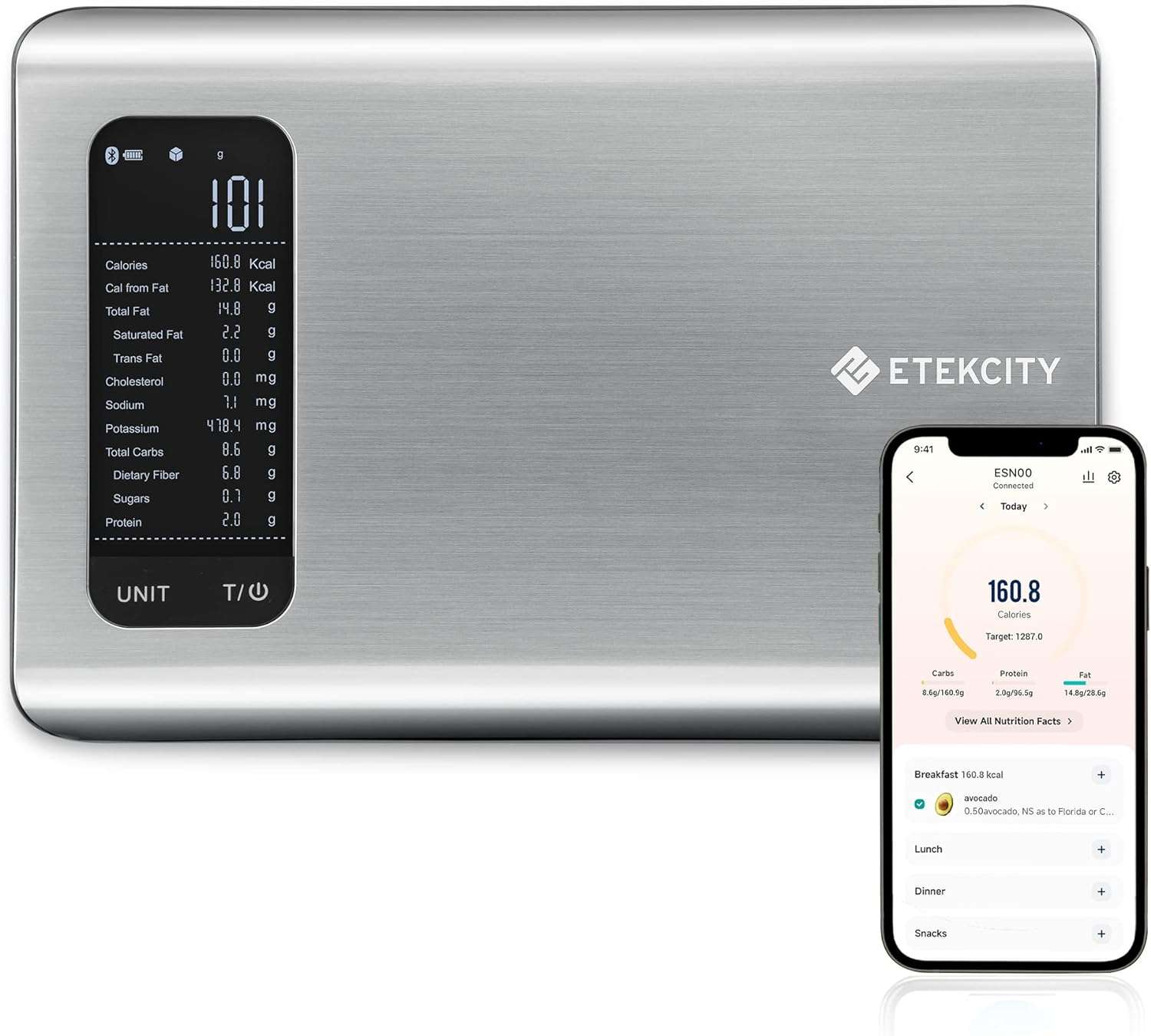Free Calorie Deficit Calculator For Weight Loss
By Chantel Ilawole | Updated April 25, 2024
Struggling to shed those stubborn pounds? You’re not alone; many face the same battle with weight loss. Our Free Calorie Deficit Calculator simplifies the process, turning complex numbers into a clear path toward your goal weight.
Calorie Deficit Calculator
Understanding Calorie Deficit and its Role in Weight Loss
A calorie deficit is when you consume fewer calories than your body needs to maintain its current weight, leading to weight loss. It plays a crucial role in losing weight, but it’s important to understand the realistic expectations and benefits of achieving a calorie deficit for sustainable results.
What is a calorie deficit?
A calorie deficit happens when you eat fewer calories than your body uses for energy. This gap means your body has to burn stored fat to get the energy it needs, leading to weight loss by reducing body fat percentage.
Your body burns calories all day long just by keeping you alive—this is called your Basal Metabolic Rate (BMR). You also use up calories through any physical activity and even while digesting food.
If you consistently consume less than what your BMR and daily movements require, you’ll start losing weight.
Eating too little can be a problem, though. Men should not go below 1,500 calories per day, and women not below 1,200 calories. If you cut back too much on eating, your metabolism might slow down.
That would make dropping pounds harder over time. It’s key to find a balance: eat enough so that your body doesn’t shut down but less than what you burn each day for steady and healthy weight loss.
How does it aid in weight loss?
Creating a calorie deficit means your body has to find energy from somewhere other than food. To do this, it starts burning fat and muscle for fuel. When you burn more calories than you eat, your body uses stored fat to get the extra energy it needs.
This leads to weight loss.
Eating fewer calories makes your body turn to its energy reserves. These reserves are mostly made up of body fat. As the fat is used up for energy, you lose weight. Our Calorie Calculator helps here by showing how reducing food intake affects losing pounds.
It gives users a clear plan by calculating daily calorie limits based on their own bodies and goals. This keeps weight loss both safe and effective.
Is losing a pound a week with a 500 calorie deficit realistic?
Losing a pound a week with a 500-calorie deficit might not work for everyone, given individual differences in calorie needs and body composition. The old rule says that cutting 3,500 calories equals losing one pound, but this often overestimates weight loss.
Your body can react to fewer calories by slowing down your metabolism, impacting the calories you burn. This slowdown makes dropping pounds harder and slower than expected.
Your weight loss depends on many things, such as your weight, age, and activity level. A 500 calorie deficit is a good start for most people wanting to lose weight. But it’s crucial to listen to your body and adjust as needed so you don’t eat too little and slow down your progress.
Benefits and Usage of a Calorie Deficit Calculator

The calorie deficit calculator helps you determine the right amount of calories to consume for weight loss. It takes into account your activity level, weight, and goals to provide personalized recommendations.
About the calculations
The calorie deficit calculator uses your body details and goal weight to generate daily calorie intakes and estimated times to reach your desired weight. It factors in a mathematical model developed by Kevin Dennis Hall, Ph.D., and a team of researchers at the National Institute of Health, which takes into account body dynamics and physiological changes during a calorie deficit state.
The calculator provides personalized tables and graphs, allowing you to select a sustainable calorie intake level that aligns with your weight loss goals.
You can use the calculator’s generated data to make informed decisions about your dietary choices and exercise routines as you work towards achieving your ideal weight. By understanding how the calorie deficit impacts your body dynamics, it becomes easier to create an effective plan for healthy weight management without extreme measures or deprivation.
How low of a calorie deficit should you go?
Aim for a calorie deficit of 500 to 1000 calories per day, ensuring it does not dip below 1200 calories for women or 1500 for men. This range supports weight loss while maintaining metabolic function and overall health, preventing adverse effects.
Opting for a lower calorie deficit can pose risks such as nutrient deficiencies, muscle loss, lowered energy levels, and slower metabolism. It’s crucial to strike a balance that promotes weight loss without jeopardizing your well-being.
How to use the calculator
To ensure a successful calorie deficit for your weight loss journey, it’s crucial to use the calorie deficit calculator effectively. Here’s how you can do it:
- Select Your Unit: Choose between metric (kilograms/centimeters) or imperial (pounds/inches) units. This will affect how you enter your weight and height.
- Input Your Body Details: Enter accurate information about your age, gender, weight, height, and activity level into the calculator.
- Select Your Activity Level: Choose the option that best describes your typical level of physical activity. The options range from sedentary (little or no exercise) to extra active (very hard exercise/sports & physical job or 2x training).
Calculate Your Calories: Click the “Calculate” button to compute your daily caloric needs. The calculator will use the Basal Metabolic Rate (BMR) formula appropriate to your sex and the activity factor to estimate your maintenance and weight loss calories.
Interpret Your Results: Maintenance Calories, is the number of calories you need each day to maintain your current weight, given your current activity level.Weight Loss Calories, is the number of calories you should consume each day if you want to lose weight. It reflects a deficit of 500 calories per day, which is typically recommended for safe and sustainable weight loss.Deficit, this shows the daily calorie reduction (500 calories) applied to achieve weight loss.
Making Informed Decisions Based on the Results: Based on the weight loss calories, adjust your daily food intake to meet the weight loss calorie target, incorporating exercise to enhance calorie deficit, regularly monitoring your progress, and consulting professionals for personalized guidance to ensure a balanced and effective approach to weight loss.
Regular Review and Adjust: As you lose weight or if your activity level changes, your caloric needs will change as well. Revisit the calculator to update your inputs and ensure your caloric intake is still aligned with your weight loss goals.
- Make Informed Decisions: Use the generated data to make informed choices about your dietary habits and overall weight loss strategy.
Factors to Consider for a Successful Calorie Deficit
How to calculate calorie deficit, predict weight loss, choose the right calorie deficit for your body, and balance calorie deficit with exercise are important factors to consider for successful weight loss.
To learn more about these essential factors in achieving a successful calorie deficit, keep reading!
How to calculate calorie deficit
To calculate a calorie deficit:
- Determine your Total Daily Energy Expenditure (TDEE) using a reliable calculator or by multiplying your Basal Metabolic Rate (BMR) by an activity multiplier based on your lifestyle.
- Set a realistic weight loss goal, aiming for a modest deficit of 500-1000 calories per day to lose about 1-2 pounds per week.
- Calculate your daily caloric intake by subtracting the desired deficit from your TDEE to maintain your current weight or lose body fat.
- Monitor and adjust your calorie intake and physical activity to sustain progress without compromising health or energy levels.
- Seek guidance from a healthcare professional or registered dietitian for personalized advice and support in maintaining a healthy calorie deficit.
Predicting weight loss
To forecast weight loss, use the calorie deficit calculator to estimate daily caloric intake required for reaching your goal weight. The calculator factors in body dynamics and physiological changes during a calorie deficit state, providing an estimated time frame to achieve the desired weight based on specific daily calorie intakes.
Additionally, it incorporates Total Daily Energy Expenditure (TDEE) and Resting Metabolic Rate (RMR) calculations as well as recommendations for macronutrient intake amounts based on the necessary caloric intake to reach the goal weight.
Choosing the right calorie deficit for your body
To choose the right calorie deficit for your body, consider preserving muscle mass through regular exercise and a balanced diet during weight loss. The online calculator is based on a mathematical model developed by Kevin Dennis Hall, Ph.D., and a team of researchers at the National Institute of Health.
This ensures accurate recommendations for intake amounts for macronutrients based on the required caloric intake to reach the goal weight, contributing to sustainable weight loss without compromising lean muscle mass.
Balancing calorie deficit with exercise is pivotal in achieving successful weight loss while maintaining muscle mass. By understanding how to calculate and predict weight loss effectively, you can make informed decisions about choosing the right caloric reduction that suits your body’s needs.
Balancing calorie deficit with exercise
Exercise plays a crucial role in balancing calorie deficit for successful weight loss. It helps create a larger calorie deficit, leading to more significant weight loss. When factoring in exercise, the calculator allows users to adjust their daily calorie intake accordingly based on their exercise routine, emphasizing the need to consider the type and intensity of exercise for sustainable and healthy weight loss.
FAQs and Common Misconceptions about Calorie Deficit
Can you build muscle on a calorie deficit, considering the calorie content needed for muscle growth? Is it safe to eat below 1200 calories a day? How to calculate calorie deficit using BMR?
Explore these common questions and misconceptions about calorie deficit for weight loss.
Can you build muscle on a calorie deficit?
Building muscle on a calorie deficit is possible with the right approach. Adequate protein intake and resistance training are key to preserving and even building muscle while in a calorie deficit.
Including strength workouts helps maintain muscle mass, while sufficient protein supports muscle repair and growth. Remember, the focus should be on gradual fat loss rather than rapid weight reduction to minimize muscle depletion.
To build muscle on a calorie deficit, Consume enough high-quality protein.
Is it safe to eat below 1200 calories a day?
Eating below 1200 calories a day is generally not safe, particularly for women. Consuming too few calories can slow down metabolism, making weight loss slower and more difficult. For men, it is generally not safe to eat below 1500 calories a day.
General recommendations caution against eating too few calories as it can have negative health effects.
How to calculate calorie deficit using BMR?
To calculate calorie deficit using BMR:
- Calculate your Basal Metabolic Rate (BMR) using the Mifflin – St Jeor equation, which considers gender, age, weight, and height.
- Multiply your BMR by an activity factor to find your Total Daily Energy Expenditure (TDEE), reflecting the calories burned through daily activities and exercise.
- Determine the calorie deficit by subtracting a set amount of calories from your TDEE, usually within 500-1000 calories per day for gradual weight loss.
- Monitor and adjust your calorie intake based on changes in weight and metabolic rate to sustain progress over time.
Other related calculators and resources
Find additional tools such as the Harris-Benedict equation and Mifflin St Jeor equation to calculate BMR. Also, consider using the Body Mass Index (BMI) calculator for assessing weight status.
These resources aid in estimating caloric requirements and monitoring weight changes.
Explore nutrition labels to make informed food choices based on sugar intake, portion control, and overall calorie reduction. Registered dietitians can provide personalized guidance for healthier eating habits and developing a balanced meal plan that aligns with dietary guidelines for Americans.
In conclusion, the free calorie deficit calculator is a valuable tool for understanding weight loss. It provides insight into realistic weight loss goals and necessary calorie intakes.
Users can customize their approach to achieve their desired results, dispelling common misconceptions about calorie deficits. With its comprehensive information and related calculators, it equips individuals with the knowledge needed to manage their caloric intake effectively.
FAQs
1. What is a calorie deficit, and how does it help with weight loss?
A calorie deficit occurs when you consume fewer calories than your body needs to maintain its current weight. This deficit forces your body to turn to its fat stores for energy, leading to weight loss.
2. How does being very active or having a sedentary lifestyle affect my calorie needs?
If you’re very active, your body burns more calories, so you need more food energy. With a sedentary lifestyle, you burn fewer calories and need less food to avoid weight gain.
3. What factors determine the ideal calorie deficit for weight loss?
The ideal calorie deficit for weight loss varies based on factors such as your current weight, activity level, metabolism, and weight loss goals.
4. Is a 500-calorie deficit per day ideal for weight loss?
A 500-calorie deficit per day is a common recommendation for weight loss, as it can lead to a gradual and sustainable loss of about 1 pound per week.
5. Will cutting down on drinks like sodas help me lose weight?
Yes! Reducing sugary drinks like sodas can decrease your caloric intake and may prevent chronic diseases such as heart disease and high cholesterol.
6. If I’m overweight, will the free calorie deficit calculator consider health issues related to obesity?
It factors in concerns linked with a high BMI, such as sleep apnea or heart ailments while guiding towards safe ways of losing weight through caloric restriction.













